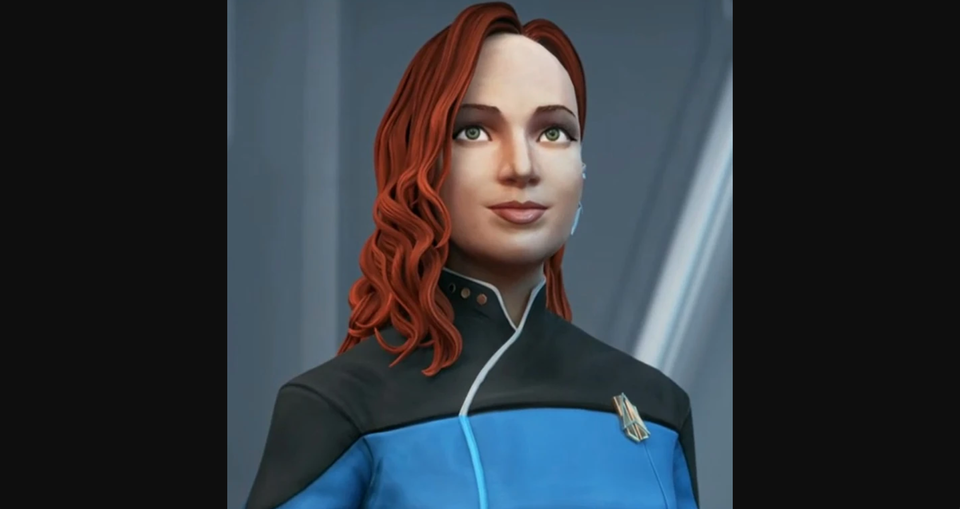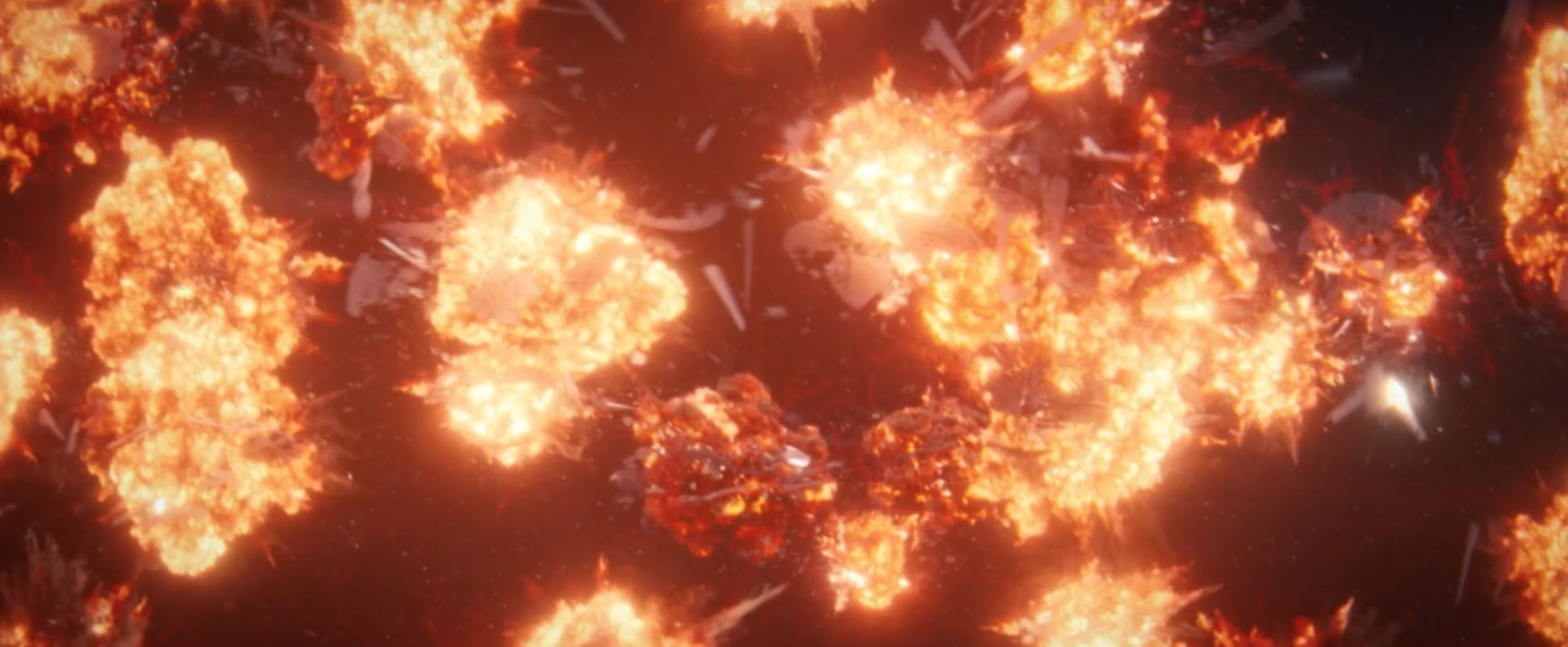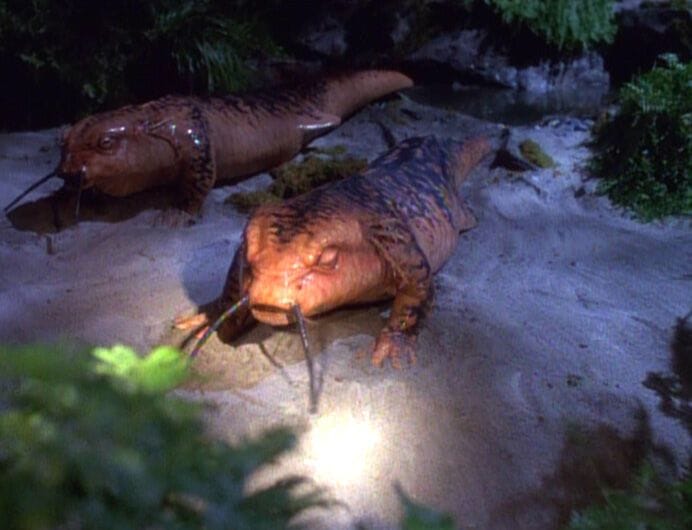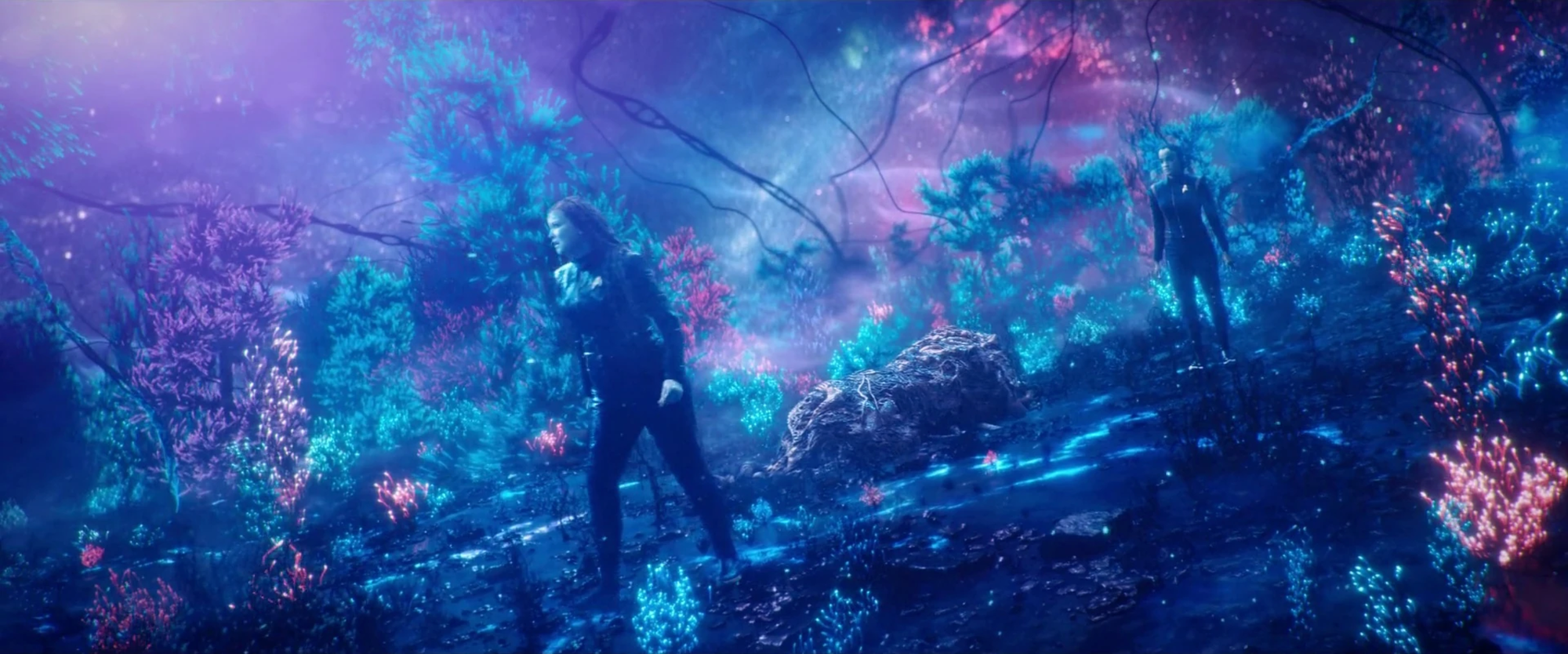An exclusive interview with Star Trek science advisor Erin MacDonald

Season 2 of Star Trek: Strange New Worlds goes boldly in many new directions for the series. But its most audacious moment isn't when Illyrian civil rights attorney Neera Ketoul calls out Starfleet's hypocrisy for discriminating against genetically modified people, or even when two lower deckers from the USS Cerritos stumble into the live-action universe of Strange New Worlds. It's when Uhura broadcasts a song into a fold of subspace, accidentally generating an "improbability field" that traps the ship in an alternative reality where everyone is forced to express themselves through music.
That is the surprisingly thought-out explanation for Subspace Rhapsody, Star Trek's very first musical episode, in which the crew of the USS Enterprise must figure out how to close the improbability field before disaster ensues. As Spock and Uhura attempt to analyze the phenomenon, they and other members of the crew begin spontaneously breaking into song, leading to embarrassing and character-revealing moments as the rules of the musical universe force them to divulge their innermost feelings. It could have gone off the rails quickly. But the episode manages to tell an entertaining, and very Trek-y, story about a crew trying to regain control of their ship after encountering an unexplained space anomaly. And the musical performances are pretty damn impressive, too.
The fact that this episode didn't feel like a gimmick is largely thanks to the input of Erin MacDonald, Star Trek's resident science advisor, who consults on every series currently in the works. MacDonald, who earned her Ph.D. in astrophysics before pivoting to a career in science communication and eventually getting hired to consult for Trek, worried that the musical episode would be impossible to explain with science. But when the writers insisted they needed a scientific reason for Spock to spontaneously start crooning about the intermix chamber, MacDonald rose to the challenge.
I recently spoke with MacDonald for a National Geographic article on science in science fiction. That article contains some highlights of our conversation on the science of Star Trek, but the entire interview was too damn interesting not to publish in full. It can be found below, lightly condensed and edited for clarity.
Maddie Stone: Before we get into Star Trek, I was hoping you could introduce yourself and tell me a little about your career trajectory. I thought I had a pretty cool job, but you have a really cool job! I want to hear how that came about.
Erin MacDonald: It was definitely a little bit of a journey figuring out what I wanted to do and what I was interested in. I went through the traditional academic route. I did my undergraduate in physics and math at the University of Colorado, Boulder. Then I went and did my PhD at the University of Glasgow, Scotland, specifically in gravitational waves. So I was an astrophysics PhD focusing on general relativity and gravitational waves.
And then I did a postdoc, and that was the moment where I was like 'Oooh, no, I didn’t go into this wanting to be a professor, I was just interested in the research side'. This was before gravitational waves were discovered, so jobs were few and far between. So, I finished that postdoc and I left.
And then I started doing teaching. So I would teach at community colleges, science museums. And it was all kind of just cobbled together, part-time work. So paying the bills was pretty tough.
Then I got a job doing aerospace engineering as a technical advisor. I was surprised at how similar that job was to academia. It was absolutely doable and I really enjoyed it. But I really missed teaching, so I would go to science fiction conventions and give talks on the science behind science fiction. Things like video games, even Star Wars, anything and everything I was interested in because I’m a big sci-fi fan anyway.
And then, just between personal and professional life I moved to Los Angeles, still working as an aerospace engineer. But I’d met a lot of people at these sci-fi conventions who started plugging me into friends and colleagues who were writing sci-fi and wanted a scientist to talk to.
When it comes to Star Trek, that was similarly friends of friends. Someone was working for Star Trek, they were getting all these shows underway, and they asked me to give my convention talks at their official convention. And that’s how I got on Star Trek’s radar. And then, when Michelle Paradise took over for season 3 of Discovery, she wanted to hire a couple of scientists to help with that. And that’s how I got involved. In 2019 they brought me on, basically on retainer, as their official science person for the entire franchise.
Maddie: So you now are the science advisor not just for Discovery, but Strange New Worlds, Lower Decks—all the shows that are currently airing or in production?
Erin: Yeah. The only seasons I didn’t work on were Season 1 of Lower Decks and Season 1 of Picard. [Editor’s note: MacDonald later clarified that she didn’t work on Seasons 1 or 2 of Discovery, either.] They were already written by the time they brought me on.
And all the shows use me to different extents. However much or little they want to.
Maddie: Can you talk about what that job looks like day to day? How much do you interact with the writers and producers, and what sorts of things are you asked to weigh in on?
Erin: Similarly, it varies. I think the thing that’s consistent no matter what show is that I get all the script versions for all the shows. When multiple shows are in production, that can get a little bit crazy with versions coming in. So I usually have about 2 or 3 scripts I need to read per day, at the worst, and provide notes on.
And I tend to break those notes down into priorities: These are the science issues, this needs to change, it’s not worded properly. I’m always positive, but these are the priority issues. And then suggestions: This could be punched up, maybe don't explain it as much, I think it’s easier if you just cut this word out. And then just additional observations, because I’m not in the room every day, and the writers appreciate someone who’s reading it cold, offering additional thoughts.

But as I work with the rooms, that trust starts to build. And now, I’m on Starfleet Academy, and they brought me into the room pretty much from day 1. [Editor's note: Production of Starfleet Academy, an upcoming show about cadets training to become Starfleet officers at the franchise's famed school, begins in 2024.] Which is what Discovery did going into season 4. And some of these other shows, as they’re shaping the season, they bring me in early as they’re thinking, 'OK, this episode is gonna be pretty science-heavy. Let’s get you in the room while we are thinking about it so we can get ahead of any possible science issues'. So, usually about once every one or two weeks, I’ll sit in a writers' room and almost shadow more than anything. But I’m there if they have specific questions.
Sometimes I’ll meet with post-production teams, like visual effects and production designers, to try to help get the science visuals. Or if they want to run something by me [and ask] ‘Does this make you sick to your stomach to see, as a scientist?’ So it’s really wide-ranging. It’s a pretty extensive job and can be pretty busy at times.
Maddie: And how much authority do you have? Obviously in Star Trek, science has to be balanced with plot elements, visual effects, and the canon which includes lots of concepts and technologies from the 1960s when we didn’t know about exoplanets, we didn’t have the same understanding of certain principles of biology. So how much weight is scientific feedback given in the decision-making, and is there ever a tension or a sense of being at loggerheads?
Erin: Again, the relationship is different between all the shows. It’s also important to remember how many people and voices are involved in making a show. And I would say I do appreciate that my voice is respected.
Honestly, and I don’t want this to come across negative at all, I would say the show that gives me the most pushback is Lower Decks. And I’m never trying to push any science, it’s just that [they] carefully curate any science moments. So it’s more just, 'Well, what about this? OK, let’s tweak that a little bit more. Well, would this work?' So it’s a lot more back and forth than I get with other shows.
Again, none of this is contentious, but we had a bunch of back and forth in season 4 because they had the cave episode. And I was trying to give them technical terms for caves when they get in there. 'Solution cave' is the [type of] cave that they’re in. And they were like, ‘Erin, solution caves sounds made up. There’s no way that’s real. And then they went off and were like ‘Holycrap, that is the right word for it, but we hate it.’
Maddie: It sounds like some sort of psychology puzzle.
Erin: Yeah. So that was like, no. And that’s part of it too. Especially with some weird, goofy episodes, just let the science go. If you start trying to explain it, you’re gonna get in trouble, and sometimes that’s the voice I have to give. Just don’t explain it.
Maddie: Are there any canonized concepts or technologies that fall into that bucket? I’m thinking of things like di-lithium and warp drive— although NASA apparently has researched the concept of a warp drive.
Erin: It’s funny because that was happening while I was doing my Ph.D., and because it was so closely tied and I wanted to procrastinate writing my dissertation, I fell deep into the rabbit hole of how a warp drive works. I know a lot about it [laughs].
But yeah, all the canon technologies also fall to me. How transporters theoretically work. Di-lithium was actually the first job I got. That was for season 3 of Discovery and they were having The Burn. It wasn’t to be on call as a scientist. That job was much more like 'You are hired to science The Burn', and one other episode. [Editor's note: The Burn is a disastrous event that occurrs in the early 31st century. Most of the galaxy's dilithium suddenly goes inert, causing every active warp drive to go critical. Faster-than-light travel is rendered impossible, shattering the Federation.] They were very specific purviews. And I think that’s more traditional to other science advisors, where they’re brought in for a single story point, and you might interface with the writers’ assistants.
Especially with some weird, goofy episodes, just let the science go.
But yeah, having to take all of the di-lithium canon, which has been around since 1966, and build on the science without contradicting anything that’s already there. The Star Trek science is probably the more stressful part of my job, if I’m honest.
Maddie: Is there a specific Star Trek show or movie that you’re particularly fond of because of the way science is represented?
Erin: So removing all the ones I’ve worked on because I’m super biased for those, my favorite Star Trek series for science is Voyager.
When I’m giving science talks about Star Trek, all of my examples are coming from Voyager—the way they talk about neutron stars, the way they talk about warp drives. And I think it’s inherent to the plot of the show, given that Janeway is a science officer at her core. And they’re in a new part of the galaxy, discovering new things. A lot of the show is ‘Yes, we’re trying to get home, but also we have a job to do so, we should go look at that shiny supernova over there.'
Maddie: I also feel like Voyager is the series where they ratchet the technobabble up to 11. It’s just a whole ‘nother level compared with Deep Space 9 and The Next Generation.
Erin: Absolutely. It’s funny because there are a couple of episodes—obviously Threshold is one people bring up a lot. [Editor's Note: Threshold is an episode of Star Trek Voyager in which Tom Paris breaks the 'transwarp' (aka warp 10) threshold, causing him to inexplicably begin 'de-evolving.' It ends with Paris and Captain Janeway having salamander babies on a swamp planet, for reasons.] I’ve watched it so many times because it gets referenced with warp drives. And actually, the way they talk about warp drives is really great. The idea that there’s an exponential limit to warp drive, that you bend all of space and time around your ship. It’s the whole evolution into salamanders [where] the episode falls apart.

Maddie: Maybe this is my own bias because my undergrad degree was in biology, but I do think—at least in ‘90s Trek—the biology episodes were a little dicier than some of the astronomy and physics-heavy ones. And yeah, they really took some creative liberties with the concept of evolution there — and in that other TNG episode where the crew all 'de-evolve' into spiders and frogs [Editor's note: I'm referring to the episode 'Genesis' from Star Trek: The Next Generation].
Erin: Professor Mohammed Noor did all the biology on season 3 of Discovery. He has a great talk about evolution in Star Trek, and he brings up all those episodes. It’s like 'Here’s the evolutionary tree, and here’s what’s called common ancestors. You don’t de-evolve up a branch and down another branch.'
Maddie: So Voyager is your favorite show for science overall. From the shows you’ve worked on, do you have a favorite scientific thing you’ve been asked to weigh in on?
Erin: I’m really still attached to the science of The Burn. We did some deep-cut stuff.
The science we created for di-lithium was basically like, di-lithium has a component—and this is sci-fi—that will be the key to dark matter. So it’s more like we discovered dark matter and then we discovered this subatomic particle that can exist in subspace. So down to the subatomic, gluon level, you have, 'complex bosons'. Complex in the sense that you have real space and you have imaginary space, which can be thought of as subspace, and you have these particles that are able to exist in that [subspace] realm.
So this idea of complex bosons and these subspace, subatomic particles, has crept its way into other episodes where we’ve needed a science solution. So I’m really proud of that, because not only did that solve the di-lithium and The Burn problem, but that science is continuing to build in the Star Trek canon. Which is all made up, but it’s pretty cool.
Maddie: So it’s like you’re building your own additions to particle physics? So, what if scientists discovered this additional particle, and how could that explain di-lithium?
Exactly. That was kind of the train that my brain went down coming up with that. And what was cool is we never tied it to dark matter in the episode. The brief explanation is like, two lines long, for all this science.
But they discovered the di-lithium-rich planet in a dark matter nebula that we named the Verubin nebula after Vera Rubin, who’s the woman who discovered dark matter. So that was like, a little sciencey Easter egg.
One more brief example: I talked about how a lot of the job is when you have these crazy episodes to just say ‘Don’t explain it.’ The one time I ever got serious pushback from that was the Strange New Worlds musical episode. They were like ‘No no no, we need a scientific explanation for this.’ And I was like ‘Are you kidding me’? So, all of the stuff with the tear and the multiversal concepts, all of that is carefully curated. There was a serious backbone to that musical episode.
Maddie: I was really impressed that the show went out of its way to scientifically explain what was going on [in Subspace Rhapsody]. As a Star Trek fan, I wasn’t even expecting that. So, kudos.
Erin: It was fun, and I was really proud of it because it was still rooted in science. At the end of the day, it did feel Trek-y.
Maddie: So I also have to ask, since you work on Discovery, about the mycelial network. [Editor's note: Seasons 1 and 2 of Discovery introduce a universe-spanning network of fungal mycelia that Starfleet can access and use to travel instantaneously to distant places via a fungal 'spore drive'.] I studied soil science in grad school and worked with fungi, so it was very clear to me that someone on the show really loves fungi. Was that you, or someone else?
Erin: So all of that was in seasons 1 and 2 which I did not work on. So there’s a lot of speculation, because I wasn’t there, of where that came from because they changed show-runners so much.
Mohammed went down a rabbit hole and he discovered that Bryan Fuller, who originally wrote the pilot for Discovery and pushed it into concept, had retweeted Paul Stamets’ Ted Talks. [Editor's note: Paul Staments is a mycologist who writes and speaks prolifically about the amazing properties of fungi. In 2008, he gave a now-famous Ted Talk about how mushrooms can save the world.] And we were like, 'Oh shit, that’s where he got it from. If he’s seen his Ted Talks that’s where he got it from.' And then obviously, they named the scientist [on Discovery] Paul Stamets.

Mohammed and I have worked together to retcon the scientific explanation for the mycelial network in a way that we can work with and doesn’t break our brains. And I think we’ve done it. And part of it is thinking about those subatomic, subspace particles. It’s an exotic particle that behaves like a fungus that can tap into subspace. So it’s not literally a fungus. And it is a cop-out, but we kinda used that in the same way that they have the tardigrade Ripper. They say it’s a 'tardigrade-like' creature. It’s not a tardigrade, but they keep calling it a tardigrade. So we were like, 'Well, if they’re going to do that, the spore network is not literally fungus, they just talk about it like it’s a fungus'.
Maddie: I appreciate that. As someone with more of a background in fungal biology, I see where all the inspiration came from, but I also feel like somebody went on an acid trip putting this together.
Erin: You will notice we still use the spore [drive] in seasons 3 and 4, because it is a technology that is unique, but they don’t talk about the science that much.
Maddie: We’ve talked a lot about the role of science in Star Trek. But I also feel like Star Trek has had an impact on actual science. It certainly feels like it’s inspired a lot of scientists to get into their field, for one. Would you agree?
Erin: Absolutely. It’s a cyclical relationship, and I think it’s unique for a franchise that, from its core, was very science-heavy. And because it’s been around so long, you’re getting multigenerational impacts of it. You’re getting people who watched it as children who wanted to become scientists, then they introduced their children to it. And so you get this generational impact of it inspiring science and inspiring technology.
And I really believe so many people go into science because they saw something like the transporters or the replicators or the communicators and were like, ‘How does that work? It feels like we should be able to do that.' And that starts your brain thinking like a scientist, and being curious and inquisitive. That’s a legacy I’m incredibly humbled and proud to be a part of.
So many people go into science because they saw something like the transporters or the replicators or the communicators and were like, ‘How does that work?'
And that’s a great segue to talk about Prodigy. I didn’t get into Star Trek until later in life. I was in college when I discovered it. And then when I went to grad school is when I really got obsessed with it. Because, you know, grad school sucks, and it’s really hard. And I would watch Voyager and Captain Janeway would keep me going. Then I got brought on for Star Trek, this whole full circle thing, and they told me they were doing this Nickelodeon show and wanted [me] to meet with the writers. And I went in there and they were like 'We hear you have a tattoo of Voyager'. And I was like 'Yes, I do'. And they were like, 'OK, you’re gonna need to sit down'. And that’s when they told me they were bringing Captain Janeway back and I was gonna be writing lines for her, because she was their mentor.
I think what’s so special about Prodigy, not just my role in it, but its goal and its vision, is to really lean into that legacy of Star Trek and focus a show to be for kids that is to inspire them to become scientists and explorers, and just kind people. Teach those values of Star Trek, but really target it at the next generation of viewers.
So for me, being a science advisor on that, there were some science episodes we worked on, and I did do my traditional job. I wrote the equations you see on the screen, I massaged the language, I wrote some of the little sciencey bits. But a lot of what they brought me on for was to help formulate the character of Rok-Tahk. She was gonna be a young girl who discovers she wants to be a scientist and then goes on a journey of discovering what kind of scientist she wants to be. Which isn’t a story we see that often! Like, 'I know I wanna be a scientist, but what kind of scientist? What am I good at, what do I like doing?' So helping create that character was incredibly special for me. It was a unique role that I don’t really get to do on the other shows.
And just to cap that story off, they put me in Prodigy. Lieutenant Commander Erin MacDonald is a Starfleet Academy teacher that Rok-Tahk meets when they get to Starfleet.
Maddie: Without any spoilers, is there a series you’re particularly looking forward to the next season of?
Erin: I think what’s fun for me is the fact that all of the shows are very Star Trek but also very different. That’s what’s so cool: To see new people getting introduced to Star Trek.
I think what was really fun for me was that crossover episode with Strange New Worlds [and Lower Decks] went a long way to introducing people to the other Star Trek shows. That was a show targeted to more of the original series fans, to have it be Captain Pike and very episodic. My parents-in-law watch Strange New Worlds, but they don’t really watch any of the other new Star Trek. And then that crossover episode [came out] and they were like ‘Oh man, this animated show looks really funny.’ So, just realizing that there are so many different kinds of Star Trek fans out there.
Obviously, I’m excited for Starfleet Academy to happen, that’s very my jam . It’s Starfleet Academy! I’ve always wanted to live and work there. I think that one’s gonna be a lot of fun.